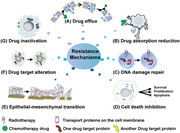- Record: found
- Abstract: found
- Article: found
Molecular mechanisms of chemo‐ and radiotherapy resistance and the potential implications for cancer treatment

Read this article at
Abstract
Cancer is a leading cause of death worldwide. Surgery is the primary treatment approach for cancer, but the survival rate is very low due to the rapid progression of the disease and presence of local and distant metastasis at diagnosis. Adjuvant chemotherapy and radiotherapy are important components of the multidisciplinary approaches for cancer treatment. However, resistance to radiotherapy and chemotherapy may result in treatment failure or even cancer recurrence. Radioresistance in cancer is often caused by the repair response to radiation‐induced DNA damage, cell cycle dysregulation, cancer stem cells (CSCs) resilience, and epithelial‐mesenchymal transition (EMT). Understanding the molecular alterations that lead to radioresistance may provide new diagnostic markers and therapeutic targets to improve radiotherapy efficacy. Patients who develop resistance to chemotherapy drugs cannot benefit from the cytotoxicity induced by the prescribed drug and will likely have a poor outcome with these treatments. Chemotherapy often shows a low response rate due to various drug resistance mechanisms. This review focuses on the molecular mechanisms of radioresistance and chemoresistance in cancer and discusses recent developments in therapeutic strategies targeting chemoradiotherapy resistance to improve treatment outcomes.
Abstract
This review discussed the molecular mechanisms of cancer resistance to radiotherapy and chemotherapy including enhanced DNA damage repair, reduced intracellular accumulation of drugs, drug inactivation, changes in drug targets, apoptosis‐growth balance disruption. We also focused on the roles of oncogenes and tumor suppressor genes in therapeutic resistance. Some anticancer drugs targeting oncogenes associated with therapeutic resistance were summarized.
Related collections
Most cited references273
- Record: found
- Abstract: found
- Article: not found
Global Cancer Statistics 2018: GLOBOCAN Estimates of Incidence and Mortality Worldwide for 36 Cancers in 185 Countries
- Record: found
- Abstract: found
- Article: not found
Molecular mechanisms of epithelial-mesenchymal transition.
- Record: found
- Abstract: found
- Article: not found
